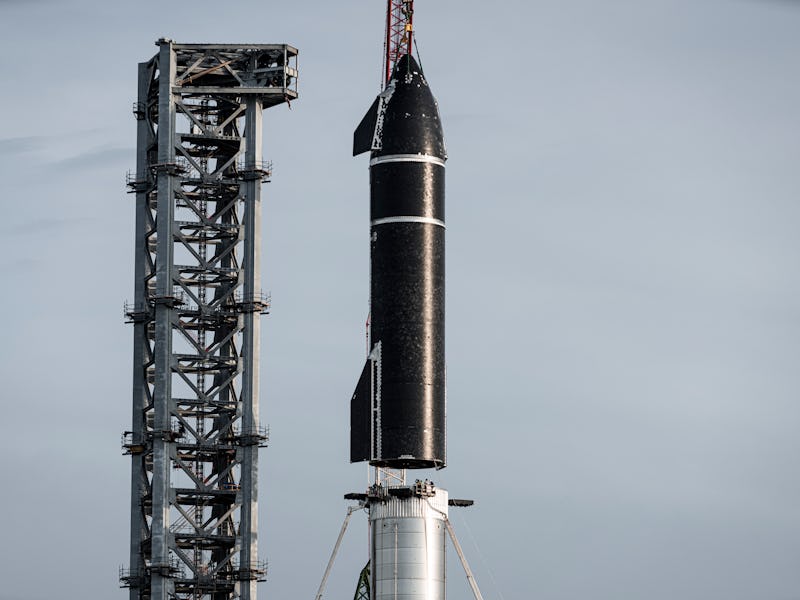SpaceX Starship: Impressive video shows the Mars-bound rocket's launch tower
The launch tower is getting bigger.

SpaceX’s Starship is gearing up for its biggest challenge yet.
On Sunday, CEO Elon Musk shared a video of the launch tower for the under-development rocket via Twitter. Located at the company’s Texas facility, the tower will support both launching and catching the giant rocket — which will help SpaceX achieve a rapid turnaround time for the fully-reusable vehicle.
The project could enable SpaceX to send the first humans to Mars. When paired with the Super Heavy booster, the giant construction stands around 400 feet tall and is designed to send over 100 tons or 100 people into space at a time. The Starship’s use of liquid oxygen and methane as fuel, rather than the rocket propellant seen with the Falcon 9, means astronauts can land on Mars, refuel using the planet’s resources, and either return to Earth or perhaps venture out further.
Watch the video below:
Want to find out more about how SpaceX and others plan to get to Mars? Subscribe to MUSK READS+ for exclusive interviews and analysis about spaceflight, electric cars, and more.
SpaceX Starship: How the new video shows significant work on ‘Mechazilla’
The video demonstrates the impressive ongoing work at the Starbase facility in Texas. The launch tower will enable SpaceX to launch the rocket and catch it as it returns, a construction dubbed “Mechazilla” by Musk.
This represents a stark shift from SpaceX’s previous rocket recovery efforts. The company has perfected its booster reuse technologies with the Falcon 9, which means SpaceX can reuse the most expensive part of the rocket to reduce spaceflight costs. But the Falcon 9 lands on either a land-based pad or a drone ship at sea, using its legs to steady itself.
The Starship’s “Mechazilla” approach means the ship won’t require those legs to return to Earth. Musk explained in August 2021 that legs would only be necessary for landing on Mars and other planets until humans build local infrastructure to catch the ships.
SpaceX will use the tower to place the 160-foot-tall ship on top of the 230-foot-tall Super Heavy booster to get the pair ready for flight. The company uses the booster to lift the ship away from Earth’s gravity, but only the ship itself will complete the trip to Mars.
Teslarati explained on Monday that the last video comes during SpaceX’s third round of testing for the tower arms. These tests involve raising the arms to the necessary height, with a steel bar between the two L-shaped arms simulating the weight of the ship.
SpaceX aims to use the Starship to send humans to Mars and beyond.
SpaceX Starship: Orbital flight details
SpaceX is gearing up to host its first orbital test flight with the Starship. This will be the first time that SpaceX has ever flown the Super Heavy booster. The ship completed a series of smaller high-altitude flights in 2021.
The plan, as outlined in a May 2021 document, will see the ship and booster lift off from Starbase. At around two minutes after liftoff, the booster will separate from the ship. The booster will land in the Gulf of Mexico around eight minutes after launch. The ship will land around 60 miles off the coast of Hawaii 90 minutes after liftoff.
The company’s orbital flight has experienced delays due to a necessary environmental assessment from the Federal Aviation Administration. This assessment is set to be released on February 28, a delay from the original December 31 deadline due to the large number of comments submitted for the draft assessment.
From there, SpaceX may host its orbital flight later in 2022. Musk has publicly stated on multiple occasions that he aims to send the first humans to Mars sometime in the 2020s, with an ultimate end goal of establishing a city on Mars by 2050.
SUBSCRIBE TO MUSK READS+, A PREMIUM NEWSLETTER THAT COVERS THE WORLDS OF ELON MUSK, SPACEX, TESLA, AND EVERYTHING BETWEEN.
This article was originally published on